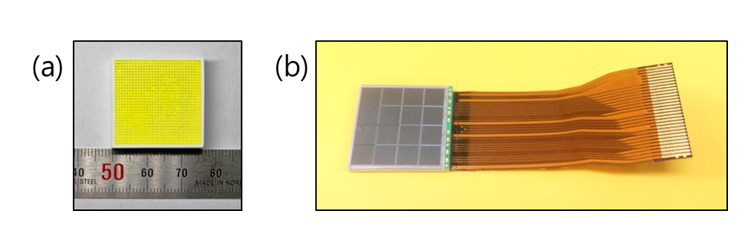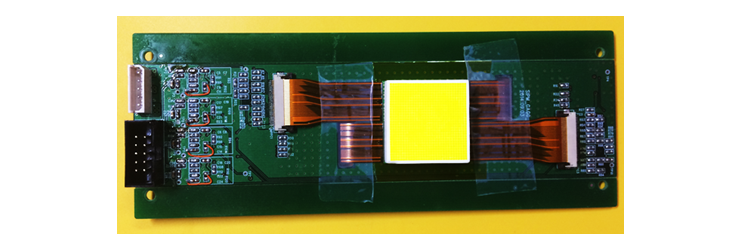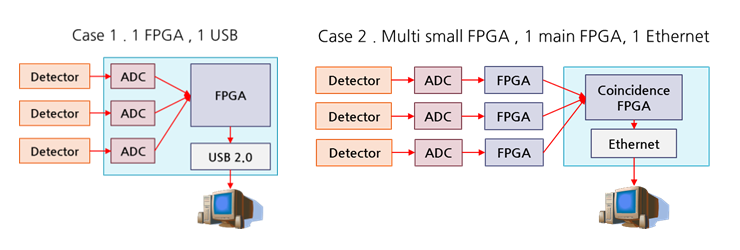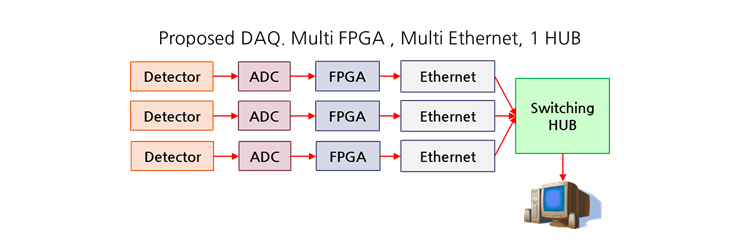ONGOING PROJECTS
- Development of Remote Radiation Detection Imaging System Mounted on a Drone
- High Resolution SPECT using Variable Pinhole Collimator
- Positioning Algorithm for CZT Virtual Frisch-grid Detector
- Multi-purpose Super-resolution Gamma Detector
- Multi-pinhole SPECT
- Low Profile Light Guide using Diffusion Film
- Advanced Reconstruction for Radiation imaging (ARRA)
COMPLETED PROJECTS
- Reconstruction of Dose Distribution in In-beam PET for Carbon Theraphy
- Image Registration for Breast Cancer Study
- High Energy Collimator Design for I-131
- Plasma-Display-Panel based X-ray Detector (PXD)
- CCD based Gamma Camera
- Abdomen Registration for PET/CT and MR images
- Performance Optimization by Patient Dose Analysis and Image Quality Assessment in CT Fluoroscopy
- Cone-beam based system matrix for a pixelated SPECT detector
- Development of Time-of-Flight Method for Improvement of Signal-to-Noise Ratio
Multi-purpose Super-resolution Gamma Detector (MSG)
Introduction
Conventional gamma-ray detector modules for nuclear medicine imaging system, such as Single-Photon Emission Computed Tomography (SPECT) or Positron Emission Tomography (PET), are separately developed to be optimized for the target radioisotopes, which have different energy peaks. Although the imaging mechanisms are different, the elements of the detector module (Scintillator, Photo-detector, Front-end electronics and Data acquisition system) are very same regardless of the system. We are developing Multi-purpose Super-resolution Gamma detector, which is practically applicable to most of nuclear medicine imaging systems.
Materials and Methods
The radioisotope for gamma camera and SPECT (20 keV – 400 keV) has relatively lower energy level than PET (511 keV). Moreover, the processing time is much faster at the detector of PET than SPECT, because PET has a coincidence time window, which usually varies 2 to 10 ns, to determine the annihilation points. For these reasons, the detectors for SPECT mostly consist of NaI(Tl) crystal and LYSO is mainly applied for PET, which has high density (7.1 g/cm3) and fast decay time (40 ns) characteristics. However, the lutetium based scintillators have own background radiation, it induced low energy resolution at low energy radiation peaks.

Figure 1. Ce:GAGG crystal array (a) and SiPM array (b)

Figure 2. Prototype MSG detector module
In this research, we selected Ce:GAGG (Fig 1 (a)), which also has a high density (6.63 g/cm3) and light yield (57,000 photons/MeV). It also has reasonably fast response time (88 ns) and no background radiation. In these reason, it is a promising scintillator for multi-purpose nuclear medicine imaging system.
For the photo detector, we selected silicon photo-multiplier (SiPM) arrays. SiPM (Fig 1 (b)) is attractive candidates for the photo-detector of nuclear medicine imaging, which is high gain characteristic and small size. The operating circuit of SiPM is relatively simpler than conventional photomultiplier tube (PMT) based gamma camera due to the low operating voltage (< 75V). Moreover, the height of whole detector system is also reduced.

Figure 3. Diagram of conventional DAQ system
Data acquisition (DAQ) system of gamma imaging system should be fast and reliable to process huge amount of gamma signal. Processes of conventional DAQ are shown in Fig. 3. A case 1 DAQ system is composed of ADCs of each detectors, one main FPGA (or micro-processor) and communication module. Data loss is occurred by bottle neck in data communication module. To reduce useless data, main post processing FPGA is used to sort only true event in a case 2 DAQ system.
Even though a case 2 DAQ system and Giga-bit Ethernet communication are used, speed limit of data transfer is theoretically 1Gbps regardless of the number of detectors. If the numbers of detectors increase, data transfer performance of each detector decrease paradoxically.

Figure 4. Diagram of proposed DAQ system
Main feature of proposed DAQ system is usage of multiple communication modules and one switching hub to guarantee detector expandability and Gbps speed of each detector as shown in Fig. 4.
Results and Conclusion
We are developing a multi-purpose super-resolution gamma detector (MSG), which has high spatial resolution and excellent expendability. We designed a compact and low profile detector with high spatial resolution and sensitivity. The Ce:GAGG crystal is suitable to develop multi-energy detectable system due to the high density, light yield and no background radiation. The silicon photomultiplier is compact, and likely to make simple readout circuit for operation and signal processing. Ethernet based DAQ system can afford massive size of data from the number of detector modules. We separated the job in three, analog readout circuit, ADC, and Ethernet based DAQ development. We expected that it is applicable to SPECT or PET detector modules.
Participating Researchers





